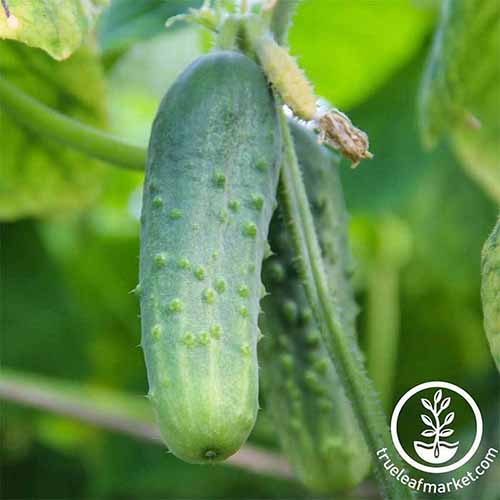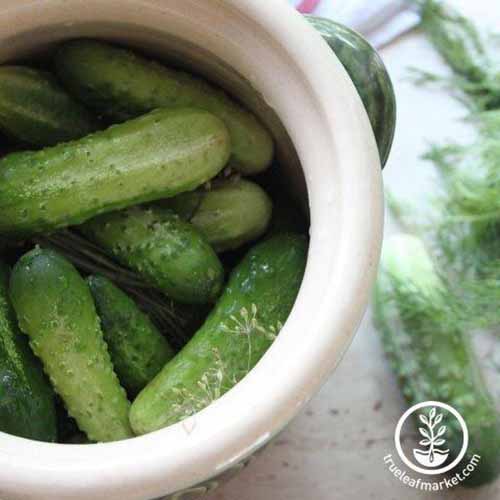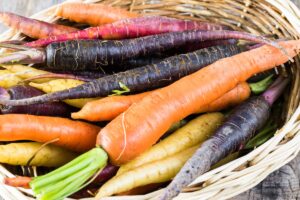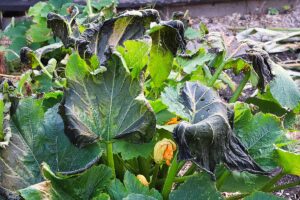What’s that expression? Quality is more important than quantity? Or is it the other way around?
When you grow cucumbers, both aspects are important, particularly at harvest time.
Sure, you can grow dozens of these cool, crispy veggies on every plant, or pick pounds at a time. But if they’re not crunchy and tasty, what’s the point?
Or maybe you’ve gone too far the other way, putting all your effort into a few perfect fruits that are hardly enough for a salad or two.
This is especially grim if you had your heart set on enough to make at least a dozen jars of homemade pickles with produce from your own garden.
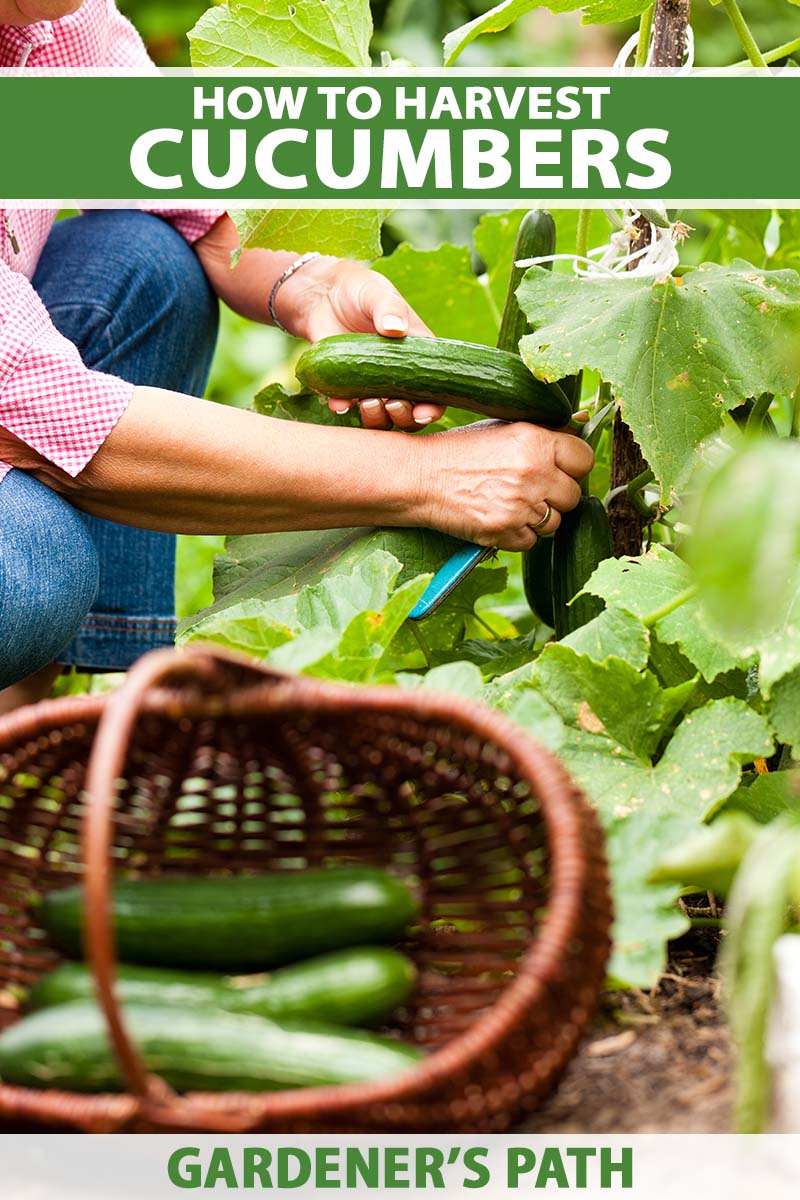
We link to vendors to help you find relevant products. If you buy from one of our links, we may earn a commission.
Here’s the good news: If you focus on your harvest from the time you select seeds right up until you’re snipping the last cukes from the stems, you can have both – high quality fruits, and loads of them.
In this article, I’ll give you a quick rundown on how to plan for a top crop. I’ll also address the best way to pick the fruits when they’re ripe, including which tools to use and avoid.
This is what you can expect:
What You’ll Learn
Prep All Season Long
Cucumbers, Cucumis sativus, tend to grow quickly and usually without too much fuss.
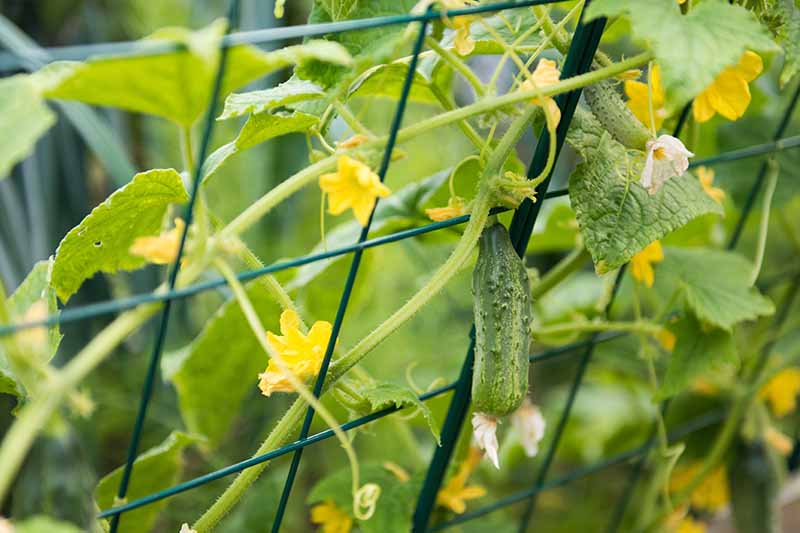
Still, there are steps you can take during the growing season – and even before you plant – that will set the scene for a productive harvest.
Here are five ways to help your vines and bushes produce tasty fruits in ample numbers, and also increase your odds of picking them at the proper time:
1. Pick the Right Variety
The end of the growing season will go more smoothly if you select a variety that’s suited to the way you plan to use the produce.

Be sure to find seeds for a “pickling” type if your end game is harvesting enough to make quantities of pickles, for example.
Varieties like ‘Boston Pickling’ produce continuous heavy yields of three-inch fruits. You can usually pick enough to make a batch of pickles from a couple of plants in just three or four days of successive harvesting.
You can find seeds available at True Leaf Market.
If you’re growing cucumbers for snacking and salads, be sure to plant slicers. They’ll supply larger, longer fruits, and each plant usually produces just one or two at a time that are ready to pick.
For gardeners who aren’t interested in preserving the surplus, they’re a better choice.
2. Set Your Schedule
Consider how long the plants will take to produce before you invest in transplants or seeds. If your summers are short and sweet, opt for the varieties that will mature on that timeline.
If you live in an area with a longer growing season, you can select cultivars that take longer to mature, like ‘Burpless Bush Slicer,’ which produces fruit as late as 65 days after sowing.
Seeds are available from True Leaf Market.
And here’s where you might think I’m going overboard, but hear me out. If you really want a bountiful and high-quality harvest, consider planting only varieties that will mature at a time when you’re sure you can keep the produce picked.
Once the crop starts coming in, picking is an every day job, especially if you’re planning to pickle or make gallons of gazpacho with the produce.
Dedicated growers will even plan vacations around the probable harvest time, and I recommend that you do, too.
3. Plant Cucumbers That Are Easy to Spot
This step may not be necessary if you’ve never had trouble with overlooked cucumbers getting so big they’re inedible, slowing your plants’ production to boot.
But if you do have difficulty spotting the fruits that need picking, consider starting with a cultivar that makes it easy.
Light-colored fruits, from varieties like ‘Lemon’ are easier to spot and pick amidst the green leaves.
Find seeds at True Leaf Market.
If light-skinned cucumbers don’t appeal to you, you may want to try growing small-leaf hybrid varieties like ‘H-19 Little Leaf.’

The leaves are smaller than standard, which makes it quite simple to find the ripe fruits.
4. Prepare Well-Draining Soil
When you have those tiny seeds in your hand, it may seem silly to be worried about cloudbursts that won’t be an issue for a couple of months.
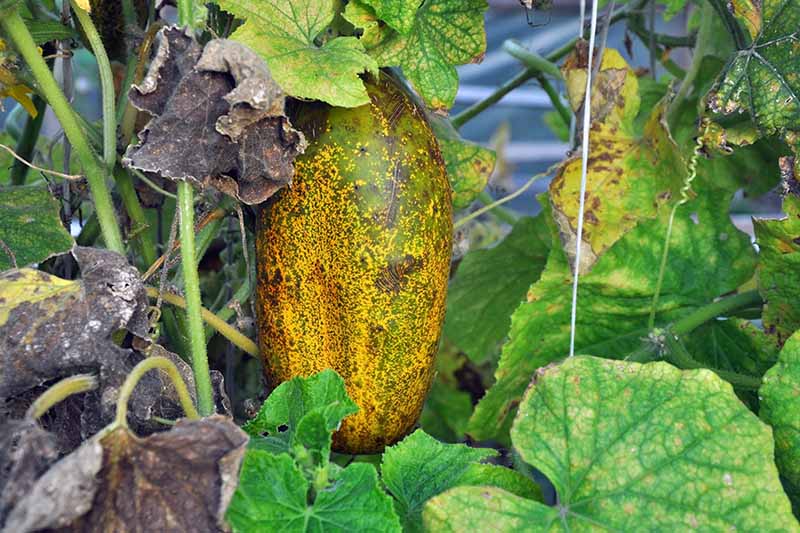
But planting cucumbers in well-draining soil amended with plenty of compost is a must if you want to avoid having to toss bloated fruits later in the summer.
While the plants need one to two inches of rain or supplemental water at the height of the growing season, they can’t handle being waterlogged.
If they do get too much water, say from a thunderstorm, and the soil doesn’t drain well, that’s when you end up with those giant, pulpy, yellow cukes with tough skins.
5. Try an Aerial Approach
Even if you have all the space in the world, if you’d like plants that will deliver high yields over several weeks or months, consider vining varieties that you can trellis.
Aerial gardening does save space, but trellised cucumbers are also easier to pick. Growing vertically involves minimal bending, stooping, or hunting, since many of the fruits develop at waist or eye level.
It’s also simpler to keep trellised vines healthy and producing, since they don’t compete with weeds, and they seldom have unpicked fruits draining their energy.
Trellising also improves airflow, which can prevent certain diseases like downy mildew or alternaria leaf spot, and ultimately improve yields.
And the space you save with aerial gardening methods will allow you to grow more plants, if that’s a goal.
When to Harvest
Size matters! For the best taste and freshness, do your best to pick cucumbers at the optimum size.
The average number of days to maturity, or a range, should be listed on your seed packet.
In general, pickling cucumbers are smaller at maturity than slicers. They’re usually ready for picking when they’re three or four inches long.
Slicing varieties are prime to pick at about six inches long, and no longer than eight inches.
Along with length, check to see if the slicers are firm, and pick them before they start to get spongy.
Should you have to err on one side or the other, choose to pick cucumbers when they are a bit smaller than full size, not a bit larger. A little extra crunch is fine, but oversized fruits are mushy, and may even be sour or bitter.
Extra big cucumbers sacrifice so much taste and texture that you probably won’t eat them, or won’t eat many.
The seeds in overmature fruits also start getting too large, which means they’re hard to chew and have the consistency of vinyl. Your aim is tender seeds and firm, crispy flesh – and for that you must pick when the fruits are not yet overripe.
If you are one of those home gardeners who loves to grow giant produce in competition with your siblings or the neighbors, try giant pumpkins or a big variety of heirloom tomato – something that’s meant to grow huge and will still look or taste great.
For all types of cucumbers, you’ll do better to pick them when they’ve just reached their ideal size, and are still sweet and crispy.
Younger fruits have the best flavor, and their removal encourages the plant to keep blooming and producing more.
If you leave them on the vine too long, this will slow production or stop it altogether.
Along with noting whether your cucumbers are big enough to pick, check out the weather forecast and plan accordingly.
Multiple cucurbit diseases are spread via wet leaves, so make sure the leaves are dry before you start picking.
How to Cut
I love snacking straight from my veggie plants as much as the next gardener, but this is not the time to rummage around in the summer garden without the best tools or storage options for the harvest.
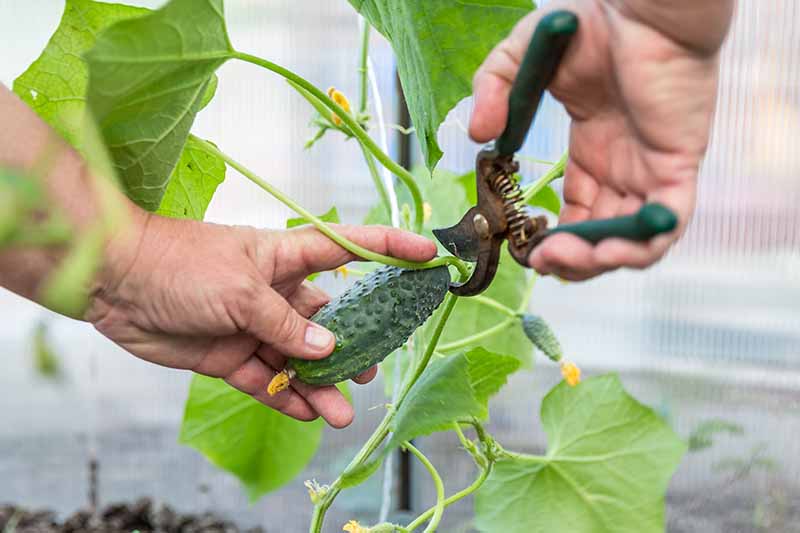
Instead, bring sterilized kitchen shears or a sharp paring knife with you as you head to the garden, along with a basket or bag to contain what you pick.
I have two other “don’ts” for you: Never twist the stem to harvest the fruit, or try to rip one off with your hands. For all their sprawl and vigor, cucumbers are just one tug away from coming completely out of the ground.
They have a tap root, but just the one. Side roots grow just below the surface of the soil, and are pulled up easily.
Once the vines or bushes come out of the ground, there’s no replanting them.

Also, avoid trying to carry the harvest in your hands as you pick. You may drop it, and slicers in particular bruise easily.
You might also slip and cut a vine instead of a stem when you’re trying to juggle cukes and scissors – or cut yourself.
A better strategy is to use both hands, one to hold the fruit gently and the other to snip it from the stem with the shears or knife. Then place it carefully in the container. That’s it!
Repeat throughout the season until the plants are finished or the weather quits cooperating.
To learn more about ways to store your bounty, see our guide to keeping cucumbers fresh in storage.
When They Get Too Large
I have one more catchy expression to add to this conversation: “Nobody’s perfect.”
Despite your best efforts, you will probably miss picking at least one cucumber in its prime, or a scad of them will all get watery and plump in a big rainstorm while you’re out of town.
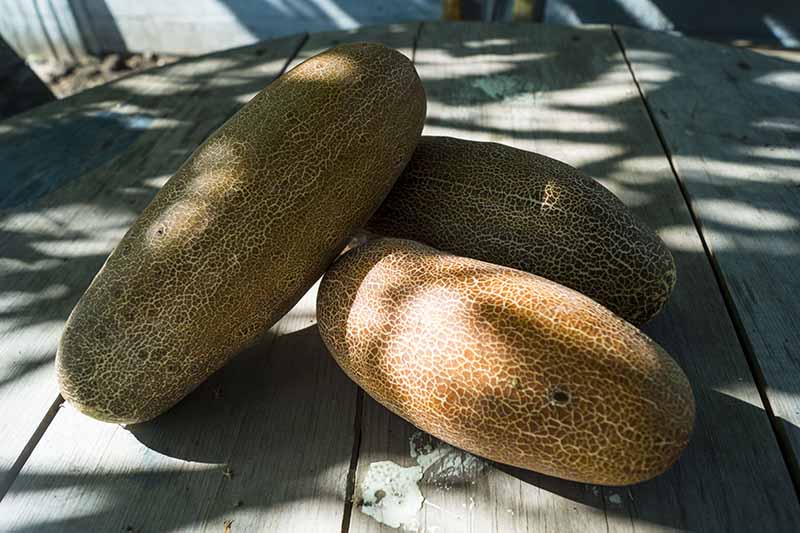
What then? Start by severing the overgrown fruit (or fruits) from the stem.
That may encourage the plant to regroup and deliver a few more fruits, or it may be a lost cause. But it’s worth a try!
If a cuke is ridiculously big, what my sister Cathy calls “see it from the kitchen window large,” just compost it.
Or if you’ve got the time and connections, check whether a local petting zoo or wildlife rescue might want your discards.
Animals including possums, geese, or even hippos and elephants relish cucurbit snacks, and have no objection to large seeds in the pulp.
If you have a friend with a flock of hens, I can assure you from experience they will happily take this overgrown produce off your hands.
The cucumbers that are just a size or two past their prime have even more uses. When I have a few of them that I’ve picked, I sample a small slice of the white flesh to make sure it hasn’t gotten too bitter.
Then I peel them, even the pickling varieties, slice them in half lengthwise, and remove the seedy pulp.
The rest makes a great base for homemade pickle relish, once you mince it fine or grate it. You can also cut it into small chunks and blend it into gazpacho.
And what if you are determined to use every morsel, because, after all, you grew this stuff by the sweat of your brow?
When I’m in that mode, I float slices of peeled, overripe cucumber in a pitcher of water with some mint and lemon to create an instant cooling, healthy beverage.
Or, I freeze big chunks on baking sheets until they’re solid, then store them in the freezer in individual sandwich bags. These are super handy as ice packs, and can still go in the compost later.
So Many Salads and Plenty of Pickles
As you wrap up the growing season, I strongly encourage you to take a few notes about what worked and what you’d do differently next time in your gardening journal.
It will come in handy to have a record of which varieties and places in the garden produced the best harvest in the right proportions.
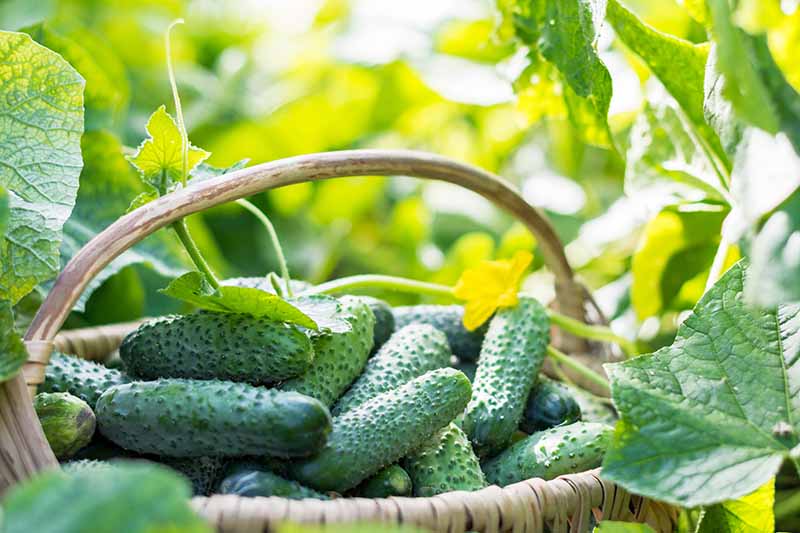
Also note whether you were able to pick cucumbers at the optimal time, so you can tweak your planting schedule next year as needed.
Many varieties are available, and they mature on different timetables, so you can time your harvest to be the most beneficial for you.
If you have any methods that have worked well for you, kindly share your experience in the comments section below.
And if you want more inspiration on choosing, growing, and caring for this cool vegetable, read these cucumber guides next:
